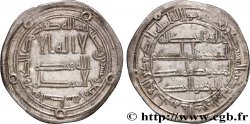fwo_563444 - OMEYYADES - HASHIM Dinar d’or 736 Syrie, Damas
недоступный.
Товар уже продан в нашем интернет-магазине (2019)
Цена: : 800.00 €
Товар уже продан в нашем интернет-магазине (2019)
Цена: : 800.00 €
Тип Dinar d’or
Дата: AH. 118
Дата: 736
Монетный двор / Город: Syrie, Damas
Металл: gold
Проба: 1000 ‰
Диаметр: 20 mm
Ориентация осей монеты: 6 h.
Вес: 4,24 g.
Редкость: R1
Лицевая сторона
Аверс: описание: Légende circulaire ; au centre, légende en trois lignes.
Обратная сторона
Реверс: Описание: Légende circulaire ; au centre légende en trois lignes.
Комментарий
Le nom du dinar vient, par le Syriaque, de denarius aureus (denier d'or). Créé en 696-697 (an 77 de l'Hégire) par le calife Abd el Malik, il a pour modèle le solidus byzantin. Longtemps frappé uniquement à Damas, la capitale, il est alors inutile d'indiquer l'atelier sur les pièces. La masse choisie, 4,25 grammes environ, est fondée sur la masse arabe d'un metqäl, mais correspond en même temps à la moyenne des masses d'un assez grand nombre de solidi alors en circulation donc un peu usés et n'ayant plus leur masse théorique de 4,5 grammes. D'après la loi dite de Gresham - la mauvaise monnaie chasse la bonne - cette très légère différence devait être un élément favorable à une rapide diffusion du dinar, au détriment du solidus..
The name of the dinar comes, via Syriac, from denarius aureus (gold denarius). Created in 696-697 (year 77 of the Hegira) by the caliph Abd el Malik, it is modeled on the Byzantine solidus. For a long time minted only in Damascus, the capital, it was then unnecessary to indicate the mint on the coins. The chosen mass, approximately 4.25 grams, is based on the Arabic mass of a metqäl, but at the same time corresponds to the average of the masses of a fairly large number of solidi then in circulation, therefore a little worn and no longer having their theoretical mass of 4.5 grams. According to the so-called Gresham's law - bad coin drives out good - this very slight difference was to be a favorable element for a rapid diffusion of the dinar, to the detriment of the solidus.
The name of the dinar comes, via Syriac, from denarius aureus (gold denarius). Created in 696-697 (year 77 of the Hegira) by the caliph Abd el Malik, it is modeled on the Byzantine solidus. For a long time minted only in Damascus, the capital, it was then unnecessary to indicate the mint on the coins. The chosen mass, approximately 4.25 grams, is based on the Arabic mass of a metqäl, but at the same time corresponds to the average of the masses of a fairly large number of solidi then in circulation, therefore a little worn and no longer having their theoretical mass of 4.5 grams. According to the so-called Gresham's law - bad coin drives out good - this very slight difference was to be a favorable element for a rapid diffusion of the dinar, to the detriment of the solidus.








 Cообщить об ошибке
Cообщить об ошибке Распечатать страницу
Распечатать страницу Отправить мой выбор
Отправить мой выбор Задать вопрос
Задать вопрос Consign / sell
Consign / sell
 Информация
Информация




